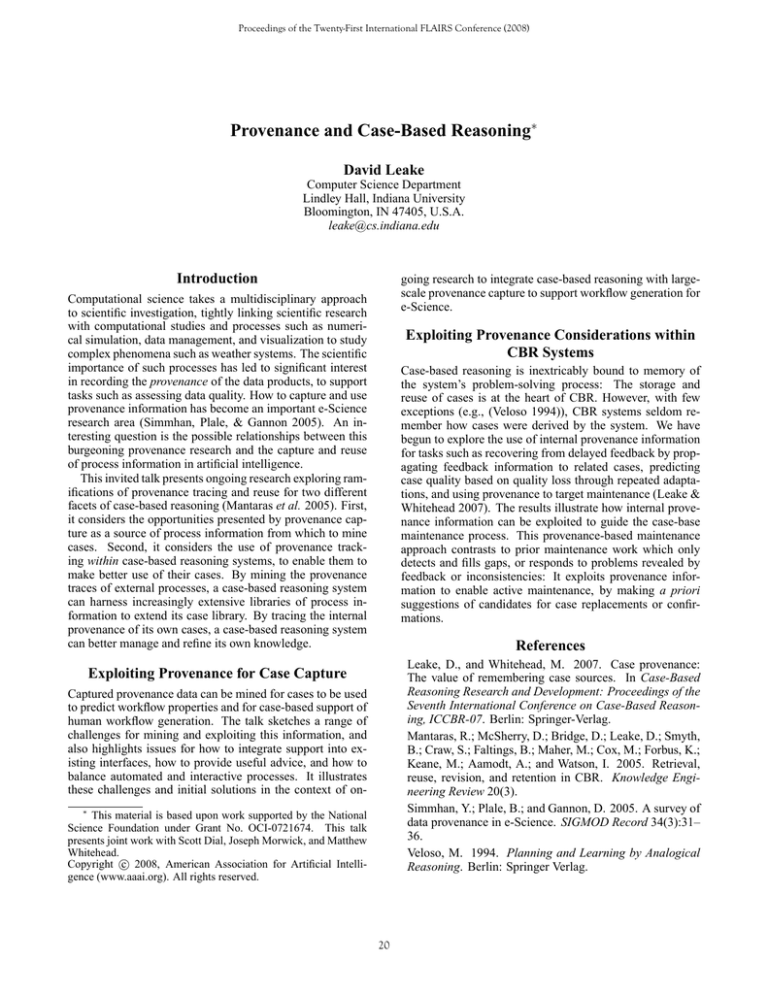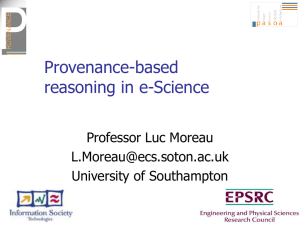
Proceedings of the Twenty-First International FLAIRS Conference (2008)
Provenance and Case-Based Reasoning∗
David Leake
Computer Science Department
Lindley Hall, Indiana University
Bloomington, IN 47405, U.S.A.
leake@cs.indiana.edu
Introduction
going research to integrate case-based reasoning with largescale provenance capture to support workflow generation for
e-Science.
Computational science takes a multidisciplinary approach
to scientific investigation, tightly linking scientific research
with computational studies and processes such as numerical simulation, data management, and visualization to study
complex phenomena such as weather systems. The scientific
importance of such processes has led to significant interest
in recording the provenance of the data products, to support
tasks such as assessing data quality. How to capture and use
provenance information has become an important e-Science
research area (Simmhan, Plale, & Gannon 2005). An interesting question is the possible relationships between this
burgeoning provenance research and the capture and reuse
of process information in artificial intelligence.
This invited talk presents ongoing research exploring ramifications of provenance tracing and reuse for two different
facets of case-based reasoning (Mantaras et al. 2005). First,
it considers the opportunities presented by provenance capture as a source of process information from which to mine
cases. Second, it considers the use of provenance tracking within case-based reasoning systems, to enable them to
make better use of their cases. By mining the provenance
traces of external processes, a case-based reasoning system
can harness increasingly extensive libraries of process information to extend its case library. By tracing the internal
provenance of its own cases, a case-based reasoning system
can better manage and refine its own knowledge.
Exploiting Provenance Considerations within
CBR Systems
Case-based reasoning is inextricably bound to memory of
the system’s problem-solving process: The storage and
reuse of cases is at the heart of CBR. However, with few
exceptions (e.g., (Veloso 1994)), CBR systems seldom remember how cases were derived by the system. We have
begun to explore the use of internal provenance information
for tasks such as recovering from delayed feedback by propagating feedback information to related cases, predicting
case quality based on quality loss through repeated adaptations, and using provenance to target maintenance (Leake &
Whitehead 2007). The results illustrate how internal provenance information can be exploited to guide the case-base
maintenance process. This provenance-based maintenance
approach contrasts to prior maintenance work which only
detects and fills gaps, or responds to problems revealed by
feedback or inconsistencies: It exploits provenance information to enable active maintenance, by making a priori
suggestions of candidates for case replacements or confirmations.
References
Leake, D., and Whitehead, M. 2007. Case provenance:
The value of remembering case sources. In Case-Based
Reasoning Research and Development: Proceedings of the
Seventh International Conference on Case-Based Reasoning, ICCBR-07. Berlin: Springer-Verlag.
Mantaras, R.; McSherry, D.; Bridge, D.; Leake, D.; Smyth,
B.; Craw, S.; Faltings, B.; Maher, M.; Cox, M.; Forbus, K.;
Keane, M.; Aamodt, A.; and Watson, I. 2005. Retrieval,
reuse, revision, and retention in CBR. Knowledge Engineering Review 20(3).
Simmhan, Y.; Plale, B.; and Gannon, D. 2005. A survey of
data provenance in e-Science. SIGMOD Record 34(3):31–
36.
Veloso, M. 1994. Planning and Learning by Analogical
Reasoning. Berlin: Springer Verlag.
Exploiting Provenance for Case Capture
Captured provenance data can be mined for cases to be used
to predict workflow properties and for case-based support of
human workflow generation. The talk sketches a range of
challenges for mining and exploiting this information, and
also highlights issues for how to integrate support into existing interfaces, how to provide useful advice, and how to
balance automated and interactive processes. It illustrates
these challenges and initial solutions in the context of on∗
This material is based upon work supported by the National
Science Foundation under Grant No. OCI-0721674. This talk
presents joint work with Scott Dial, Joseph Morwick, and Matthew
Whitehead.
c 2008, American Association for Artificial IntelliCopyright gence (www.aaai.org). All rights reserved.
20



